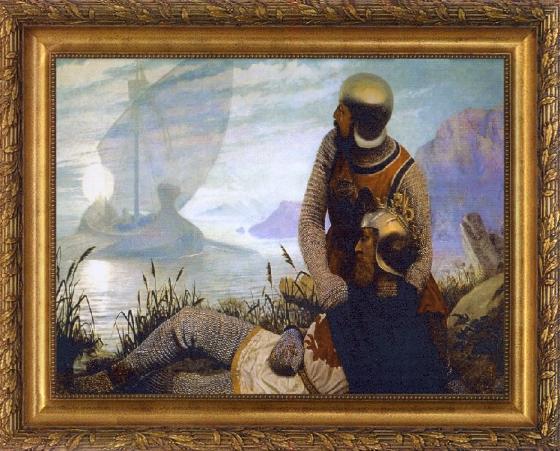



|

HEN THE CELTIC FAERIES WITHDREW from our world into their parallel one within the faerie hills, it was a place that to human visitors seemed as spacious and as full of game and forests and plains as the one above ground, and even more full of wonders and treasures. Here the Tuatha had their faerie kingdoms with occasional wars and dramas very much like those of the Sons of Mil above ground; but they also had another land off in the Atlantic to the west, the Land Under the Sunset. This was the island or islands of Hy Brasil, possibly identical with Tir na n’Og, the Land of Eternal Youth, which has many other names too such as the Land of Promise, Land of the Living, Land of Delights, the Green Isle and the Happy Plain. 
To the British Celts Hy Brasil was possibly identical with the Isle of Avalon and classical scholars have also related it to the fabled Garden of the Hesperides in Greek myth, which were also islands situated somewhere towards the sunset where magic apples grew and there was no sorrow or death. Marie de France in her Lays tells the tale of Lanval, a Breton knight in the days of King Arthur, who fell in love with a faerie maid and mounted up on her horse behind her to ride off to the Otherworld:
On the horse behind her There is a tradition in the west of Ireland that Hy Brasil becomes visible on the horizon in the direction of the sunset every seven years, and many independent witnesses have testified to this through the ages right up until a century or so ago. When Evans-Wentz was collecting stories in Ireland he was told that the summer of 1908 had been a particularly good one for sightings, with many educated witnesses of a normally sober and rational tendency. Otherwise the island only seems to show itself when its inhabitants choose, or when trouble threatens Ireland. Nevertheless, so certain were people of its existence that for several hundred years it was shown on many Atlantic charts as a real place. One of the earliest examples was in 1325 when Genoese cartographer Dalorto positioned it west of Ireland. The 1597 map below by Giovanni Magini, shows the twin island further south and marked as ‘Brafil’. It is commonly described as being a circular island more or less bisected by rivers. 
It is quite possible that the mythical Hy Brasil gave its name to the South American country of Brazil due to its legend having spread among Celtic sailors from Ireland and Britain down to Celtic Galicia in north-west Spain, and from there down into Portugal which took possession of the South American country. Although there is another theory: from the fifteenth century one of the Azores was often called the Brazil Island on Portuguese charts, probably taking its name from a type of wood found there that was used to make red dye, and it is very possible that this name was transferred to the South American colony later because even more of the same type of wood was to be found in that vast country, and it became a valuable commodity in Portuguese trade. Whatever the truth, Hy Brasil and the South American country of Brazil apparently both existed on British Admiralty charts until 1865 when the island was finally erased due to lack of confirmatory evidence.
In 1684 the Irish historian Roderick O’Flaherty wrote of Hy Brasil: ‘From the Isles of Arran and the west continent [i.e. Irish mainland] often appears visible that enchanted island called O’Brasail and, in Irish, Beg Ara. Whether it be a real and firm land kept hidden by the special ordnance of God, or the terrestrial paradise, or else some illusion of airy clouds appearing on the surface of the sea, or the craft of evil spirits, is more than our judgments can pound out.’ O’Flaherty goes on to tell of a witness then still living who claimed to have visited Hy Brasil for two days some years earlier. It apparently came about like this: in April 1668 he had a row with his wife and left home, wandering from village to village in a black mood. Then in ‘Iross-Ainhagh, in the south side of the Barony of Ballynahinshy [Ballynahinch] about nine leagues from Galway by sea’ he met three strangers who forcibly bundled him into a boat and ferried him out to a strange island. Being able to speak both English and Irish, they told him it was Hy Brasil and he was able to confirm this by picking out the Aran Islands, Golam Head and other familiar landmarks far away on the Irish coast. Then after a couple of days he woke feeling very ill on the coast near Galway with no idea how he had got back there, and had to recuperate for a few days at a friend’s house. Another of O’Flaherty’s recorded tales about Hy Brasil was this: ‘Some few generations ago, the crew of a fishing boat passing an island which they did not know, landed thereon to refresh themselves. They had no sooner landed than a man appeared and told them they had no business there as the island was enchanted. They therefore returned to the boat, but as they were going away the islander gave one of them a book with directions not to look into it for seven years. He complied with the request and when he opened and read the book he was able to practice surgery and physic with great success. This man's name was Lee, and the book remained as an heirloom with his descendants.’ A third circumstantial account he gives again offers no very solid evidence for the existence of the fabled island but does tell us much about the strength of belief in it at the time. ‘In the western ocean, five or six leagues from the continent there is a sandbank about thirty fathoms deep in the sea. It is called in Irish, Imaire Bay, and in English, the Cod-fishing Bank. From this bank about twenty years ago, a boat was blown southwards by night; next day about noon the occupants spyed land so near them that they could see sheep within it, and yet durst not, for fear of illusions, touch shore, imagining it was O’Brasail, and they were two days coming back towards home.’
Continued in the published book . . . |
|
Menu ~ Home ~ Back
|